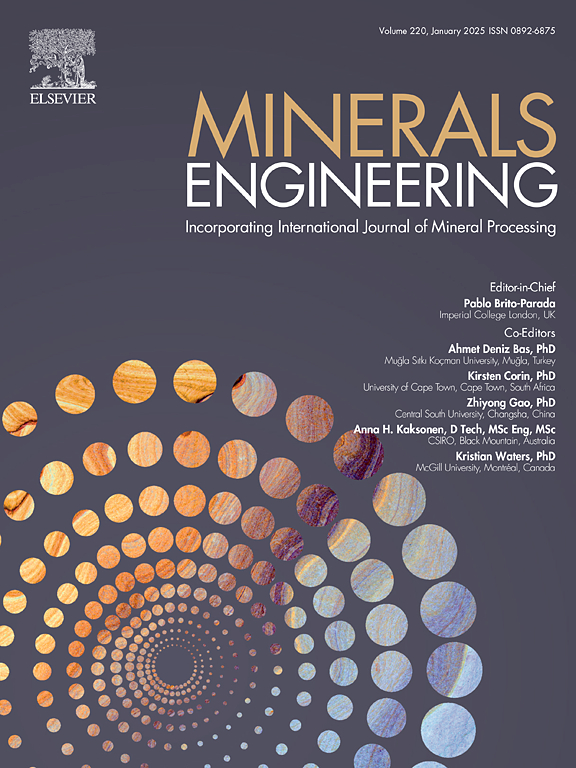不同矿物学和结构的低品位铁矿三维x射线微层析成像及扫描电镜图像分析
IF 4.9
2区 工程技术
Q1 ENGINEERING, CHEMICAL
引用次数: 0
摘要
x射线微层析成像图像分析在三维和非破坏性矿物样品表征方面显示出巨大的潜力。因此,国际科学界正在推动发展三维图象分析的新方法,并承诺在矿物加工中寻求日益准确的结果和更好的可预测性。这种研究方法的主要论点是减轻立体偏倚,这是光学和扫描电子显微镜技术分析二维(2D)图像所固有的,尽管几十年来在矿物研究中一直是非常强大、可靠和广泛使用的技术。然而,除了立体偏差外,还应考虑其他误差来源,从样品制备到不同分析技术的固有局限性。因此,这项工作旨在对具有不同矿物组合和结构关系的低品位巴西铁矿石的2D和3D矿物学结果及其对矿物解离光谱的影响进行批判性分析。在所研究的四种铁矿石样品中,样品IO-1(未释放)和样品IO-3(高释放度)的总体2D和3D氧化铁解离度没有显著差异。对于样品IO-2(在0.053 mm以下具有明显更高的解离度),与3D数据相比,2D结果高估了总体解离度9%。在样品IO-4中,尽管在- 0.15 + 0.020 mm范围内,二维解离结果在84% ~ 97%之间,但在0.053 mm以下的分数中,三维解离值达到最大值75 ~ 79%,表明所有分数的立体偏倚都很高,二维解离结果的高估为22%。本文章由计算机程序翻译,如有差异,请以英文原文为准。
Mineral liberation by 3D X-ray microtomography and SEM-based image analysis in low-grade iron ores with different mineralogy and texture
X-ray microtomography image analysis has demonstrated a great potential in in three-dimensional and non-destructive mineral samples characterization. Therefore, there is a drive from the international scientific community to develop new methodologies for three-dimensional image analysis, with the commitment to seek increasingly accurate results and better predictability in mineral processing. The main argument for this research approach is the mitigation of stereological bias, which is inherent in the analysis of two-dimensional (2D) images from optical and scanning electron microscopy techniques, despite being very robust, reliable and widely used techniques in mineral research for some decades. However, in addition to stereological bias, other sources of error should be considered, from sample preparation to the inherent limitations of the different analytical techniques. Thus, this work aims to contribute to the critical analysis of 2D and 3D mineralogical results and their impact on mineral liberation spectra of low-grade Brazilian iron ores with different mineralogical assemblages and textural relationships. Considering the four iron ore samples studied, no significant differences were observed in the overall 2D and 3D iron oxides liberation for sample IO-1 (not liberated) and sample IO-3 (with a high liberation degree). For sample IO-2 (with significantly higher liberation below 0.053 mm), the 2D results overestimate the overall liberation by 9 % when compared to 3D data. In sample IO-4, although the 2D liberation results range from 84 to 97 % in the range −0.15 + 0.020 mm, the 3D liberation values reach a maximum of 75–79 % in fractions below 0.053 mm, indicating a high stereological bias in all fractions, with an overestimation of 22 % of the overall liberation of the 2D results.
求助全文
通过发布文献求助,成功后即可免费获取论文全文。
去求助
来源期刊

Minerals Engineering
工程技术-工程:化工
CiteScore
8.70
自引率
18.80%
发文量
519
审稿时长
81 days
期刊介绍:
The purpose of the journal is to provide for the rapid publication of topical papers featuring the latest developments in the allied fields of mineral processing and extractive metallurgy. Its wide ranging coverage of research and practical (operating) topics includes physical separation methods, such as comminution, flotation concentration and dewatering, chemical methods such as bio-, hydro-, and electro-metallurgy, analytical techniques, process control, simulation and instrumentation, and mineralogical aspects of processing. Environmental issues, particularly those pertaining to sustainable development, will also be strongly covered.
 求助内容:
求助内容: 应助结果提醒方式:
应助结果提醒方式:


